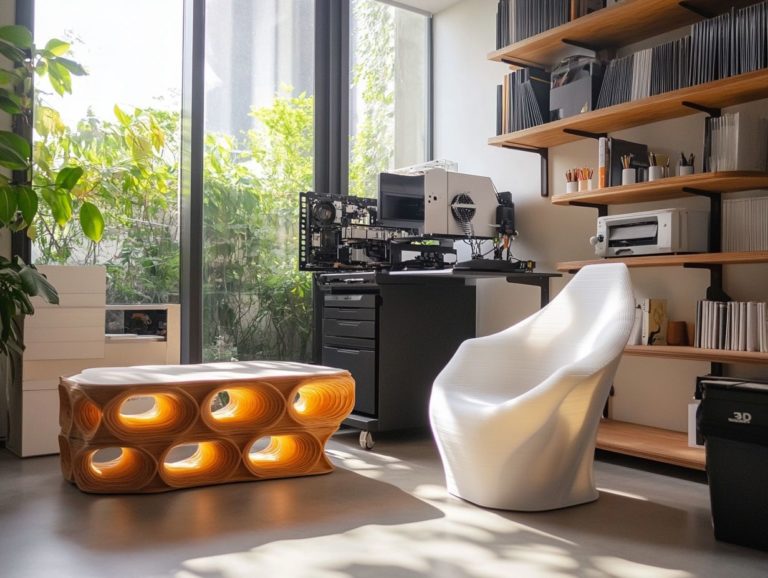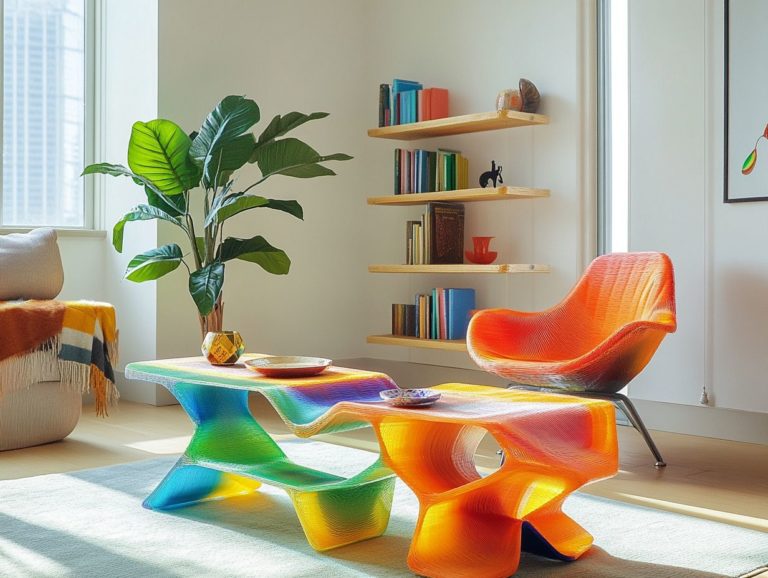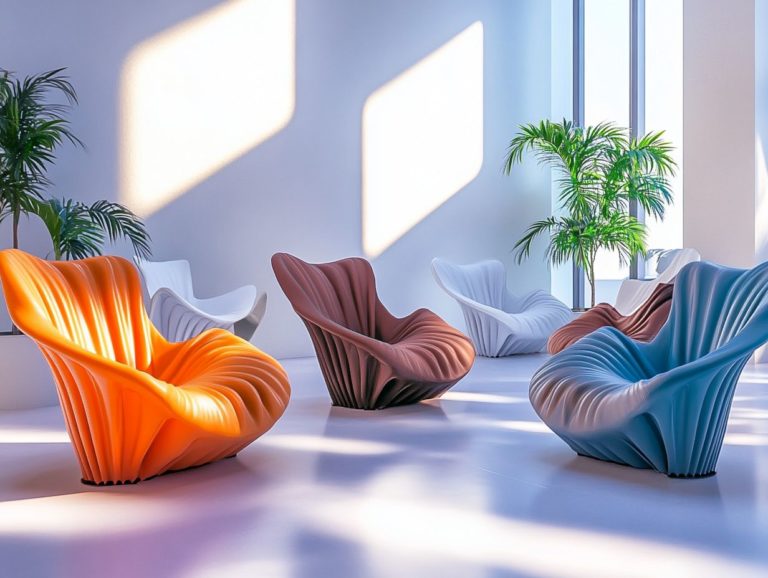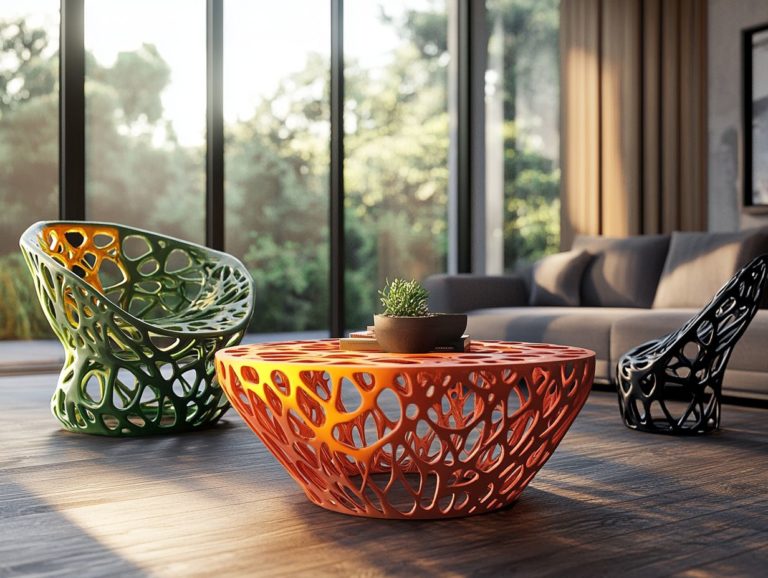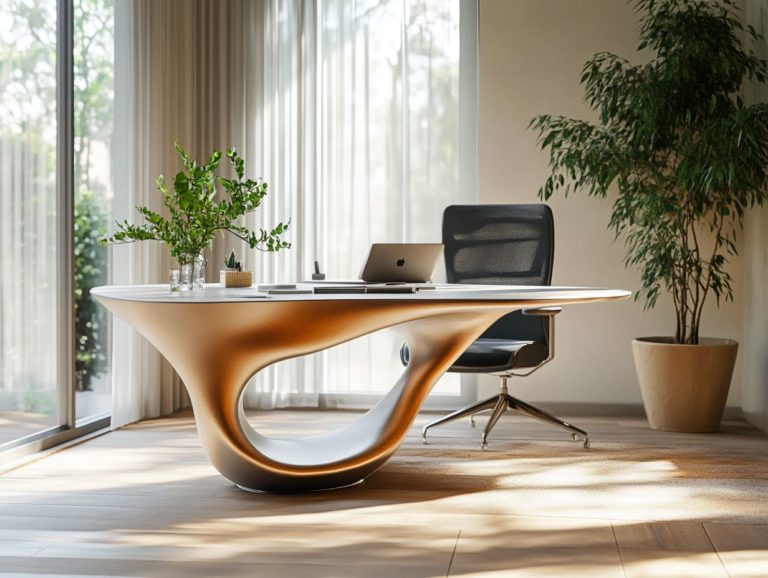3D-Printed Furniture: A Game Changer for Renters
3D printing is transforming the way you think about furniture, particularly if you’re a renter in search of stylish, functional solutions without the long-term commitment of traditional pieces.
This article delves into the numerous benefits of 3D-printed furniture, highlighting aspects such as customization, cost-effectiveness, and effortless assembly. It also candidly addresses the challenges this innovative approach encounters, including material and design limitations.
Finally, you ll discover how to seamlessly integrate 3D-printed pieces into your rental space and envision the exciting future of this technology in the furniture industry.
Contents
- Key Takeaways:
- Benefits of 3D-Printed Furniture for Renters
- Cost-Effectiveness
- Easy Assembly and Disassembly
- Challenges and Limitations of 3D-Printed Furniture
- How to Incorporate 3D-Printed Furniture into Your Rental Space
- What s Next for 3D-Printed Furniture?
- Frequently Asked Questions
- What is 3D-printed furniture and why is it a game changer for renters?
- How is 3D-printed furniture more affordable for renters?
- What makes 3D-printed furniture a sustainable choice for renters?
- Can renters customize their 3D-printed furniture?
- Is 3D-printed furniture durable enough for everyday use?
- Where can renters find 3D-printed furniture?
Key Takeaways:
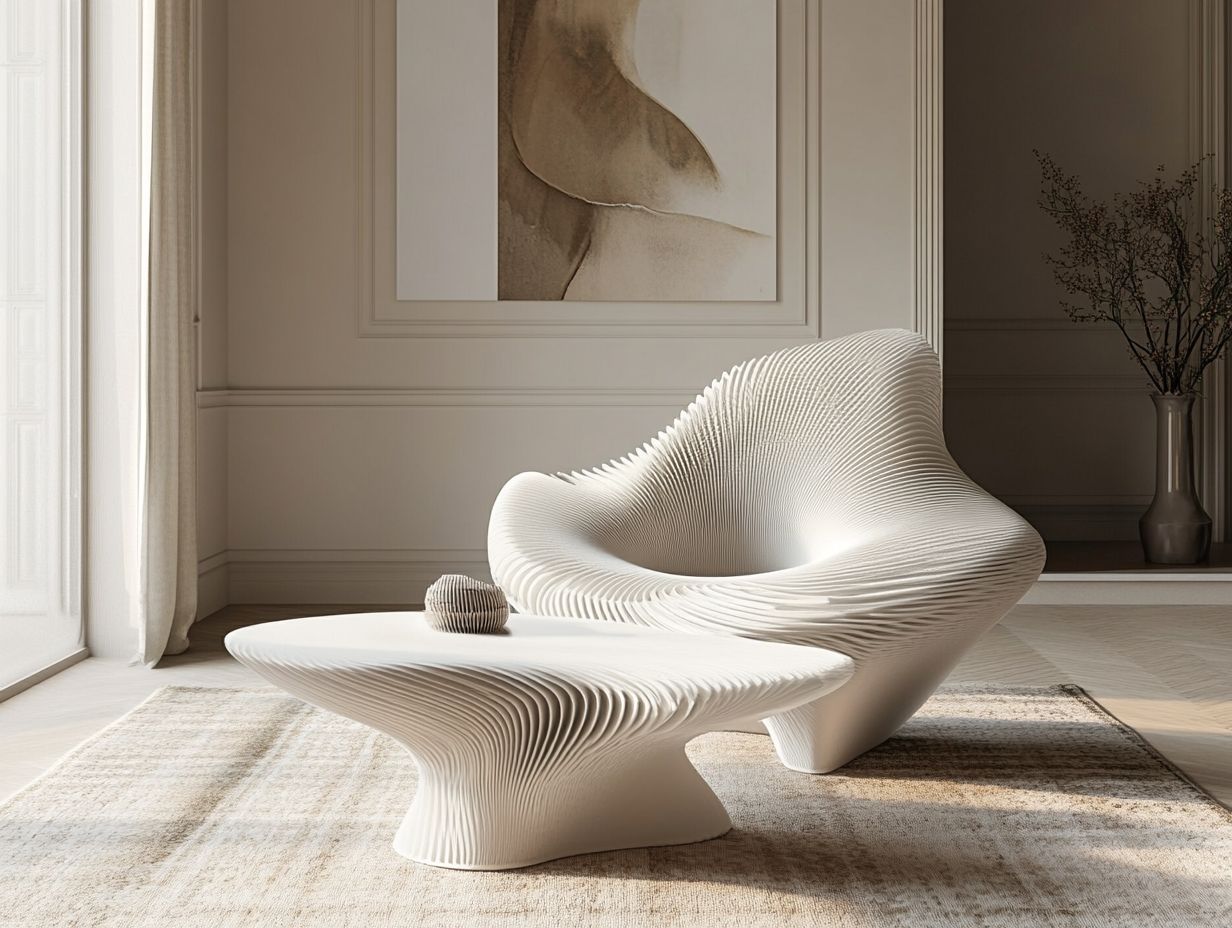
Customizable and unique 3D-printed furniture provides renters with the opportunity to express their personal style and create a customized living space.
With lower production costs and the ability to easily disassemble and transport, 3D-printed furniture is revolutionizing the market, offering a cost-effective option for renters who move frequently. Learn more about how 3D printing is changing the furniture industry.
Incorporating 3D-printed furniture into rental spaces is made easier with design tips. For those interested in this trend, understanding the rise of 3D-printed furniture highlights its potential for sustainable and affordable housing solutions, making it an attractive option for the future.
Understanding 3D Printing and Its Impact
3D printing is a game-changer, reshaping construction methods and enabling the creation of homes using sustainable materials. This innovation significantly tackles housing shortages in American cities.
Visionaries like Jason Ballard of Icon construction are at the forefront of this transformation, employing a layering technique to construct structures. With rising costs and construction challenges, this process offers viable solutions to the ongoing housing crisis driven by the demand for affordable options.
At its essence, 3D printing employs a method that builds objects layer by layer from a digital design. This approach not only reduces waste but also facilitates rapid prototyping and construction, making it invaluable in the housing sector.
With companies like Icon blazing the trail, these advancements are paving the way for more efficient home construction using sustainable resources like recycled plastics or bio-based materials, ultimately shrinking the environmental footprint. The affordability and speed of producing these homes promise to revolutionize how communities tackle urgent housing needs, opening doors for many who have faced barriers to homeownership.
Benefits of 3D-Printed Furniture for Renters
You can now enjoy the exciting luxury of customization that caters to your unique preferences and requirements. This enhances your living space while avoiding the high costs of traditional furniture.
This solution allows for energy-efficient homes and utilizes sustainable materials, supporting affordable housing initiatives in urban areas grappling with housing shortages.
Customization and Personalization
Customization and personalization in 3D-printed furniture enable you to create unique pieces that are perfectly tailored to your living space. Every item will reflect your style and meet your specific needs.
This innovative approach grants you the freedom to choose everything from color and texture to shape and size, seamlessly blending functionality with aesthetic appeal. Instead of settling for generic options that might not resonate with your home, you can design furniture that truly embodies your personal taste.
This level of adaptability not only enhances the comfort and visual charm of your surroundings but also significantly elevates the quality of your housing. By ensuring a perfect fit in both style and functionality, 3D-printed furniture transforms your overall living experience into something exceptional.
Explore the exciting possibilities of 3D-printed furniture for your own space and redefine your living experience!
Cost-Effectiveness
One of the standout benefits of 3D-printed furniture is its cost-effectiveness. This enables you to snag stylish and functional pieces at much lower prices compared to traditional furniture options. Traditional options can be quite the financial strain in today’s housing market.
By harnessing advanced technology, manufacturing times are dramatically slashed. This results in decreased labor costs and minimal waste of materials. This innovation optimizes the production process while fostering a more sustainable approach, which is especially valuable in urban areas where space is at a premium.
As designers delve into customizable and modular designs, you have the freedom to tailor your furniture to fit your unique spaces without breaking the bank. In this context, the role of 3D printing in the home furnishing sector becomes essential in promoting affordable housing solutions, addressing both your economic and aesthetic needs.
Easy Assembly and Disassembly
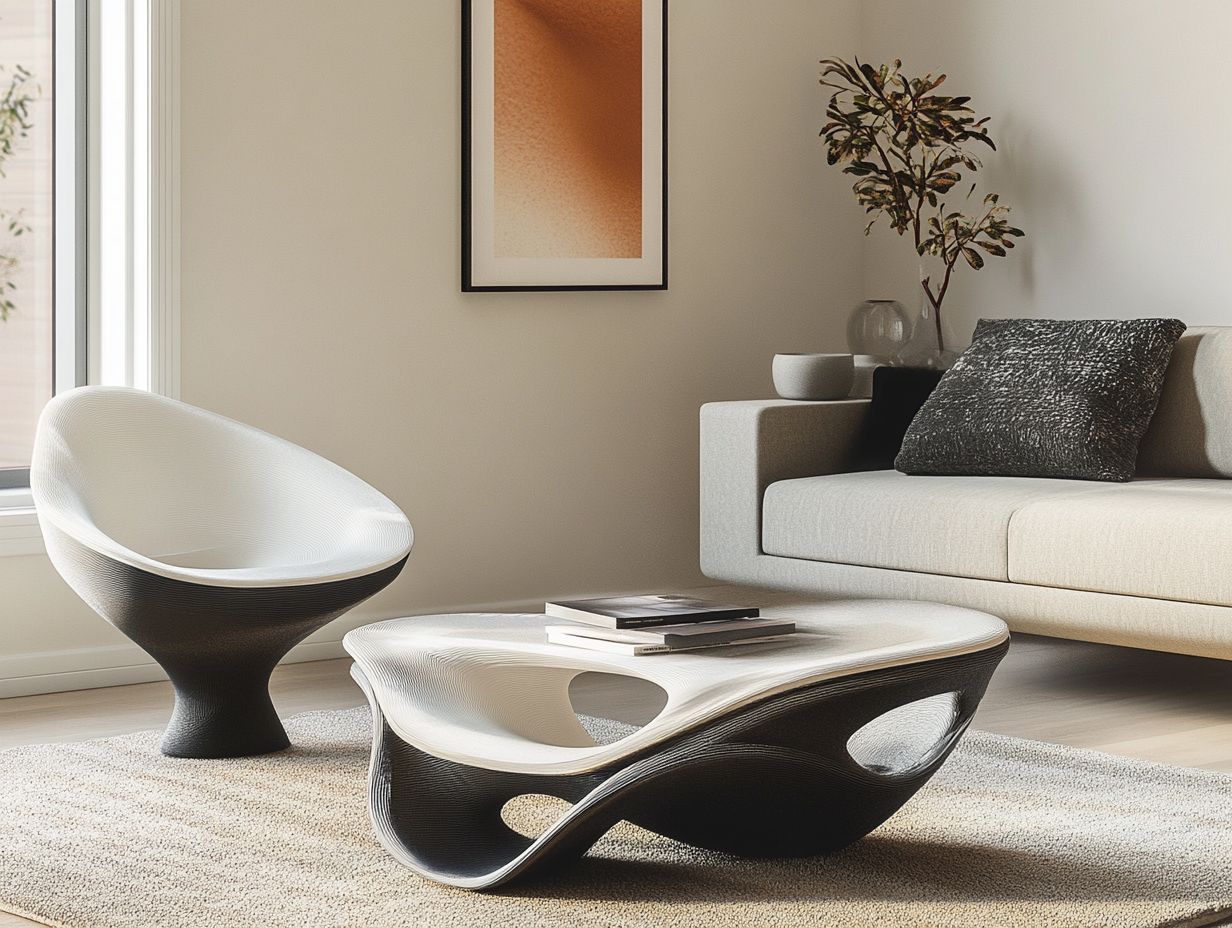
3D-printed furniture brings you the remarkable advantage of easy assembly and disassembly. This makes it an ideal solution for renters who often find themselves moving between rental apartments. This innovation simplifies the moving process and significantly reduces the environmental impact typically associated with traditional furniture disposal, highlighting the role of 3D-printed furniture in sustainable living.
This design allows for quick setup and takedown. You can effortlessly adapt your living space to your needs. Transitioning between homes becomes easy, allowing you to carry only what you truly need while minimizing the clutter that often comes with moving. This approach champions sustainable living practices by reducing waste. Instead of tossing out old furniture, you can simply disassemble these pieces, making them compact for transport or easy to store for future use.
Embrace eco-friendly solutions today! Aligning with the modern emphasis on sustainability fosters a lifestyle that values both your mobility and the health of our planet.
Challenges and Limitations of 3D-Printed Furniture
While 3D-printed furniture offers a wealth of advantages, it also presents certain challenges and limitations, especially in terms of material selection and design capabilities. These factors can significantly influence both the functionality and aesthetic appeal of the pieces you create.
Grasping these constraints is essential for navigating the dynamic landscape of sustainable furniture solutions and effectively tackling the broader construction challenges currently facing the industry.
Material Limitations
The material limitations in 3D-printed furniture can affect your ability to create items that are both durable and visually appealing. Not every material is suitable for the printing process, and many may not provide the same sustainability advantages as traditional options.
Take thermoplastics like PLA (Polylactic Acid) and ABS (Acrylonitrile Butadiene Styrene), for example. PLA is popular for its ease of use and biodegradability, but it often falls short when it comes to supporting heavier furniture pieces due to its lack of structural integrity. Conversely, ABS offers enhanced strength but comes with environmental concerns that raise questions about its long-term impact.
Fortunately, innovations in material science, such as bio-composites made from natural fibers, are paving the way for a greener future. These advancements could significantly reduce waste while enhancing the overall aesthetics of your creations. As manufacturers delve into new materials, striking the right balance between functionality and sustainability will be essential in shaping the future landscape of 3D-printed furniture.
Design Limitations
Design limitations in 3D-printed furniture can dampen your creativity and functionality. Some designs may be challenging to execute effectively with current construction methods. This ultimately affects the quality of housing you want as a renter.
These constraints often arise from material properties, printer specifications, and the complexities tied to additive manufacturing (a process where objects are created by adding material layer by layer). Certain geometric shapes might be impractical due to insufficient support during printing. This not only compromises aesthetic appeal but also impacts durability and usability of the furniture.
Limited design tools and software compatibility can restrict your creativity. Try exciting hybrid techniques that mix traditional methods with 3D printing or invest in advanced materials that enhance flexibility and strength, allowing for more intricate designs.
How to Incorporate 3D-Printed Furniture into Your Rental Space
Incorporating 3D-printed furniture can elevate your living environment. It blends aesthetic charm with practical solutions that resonate with contemporary design trends.
By selecting innovative pieces that showcase your personal style while enhancing functionality, you can craft spaces that are not only inviting but also highly efficient.
Tips for Choosing and Designing 3D-Printed Furniture
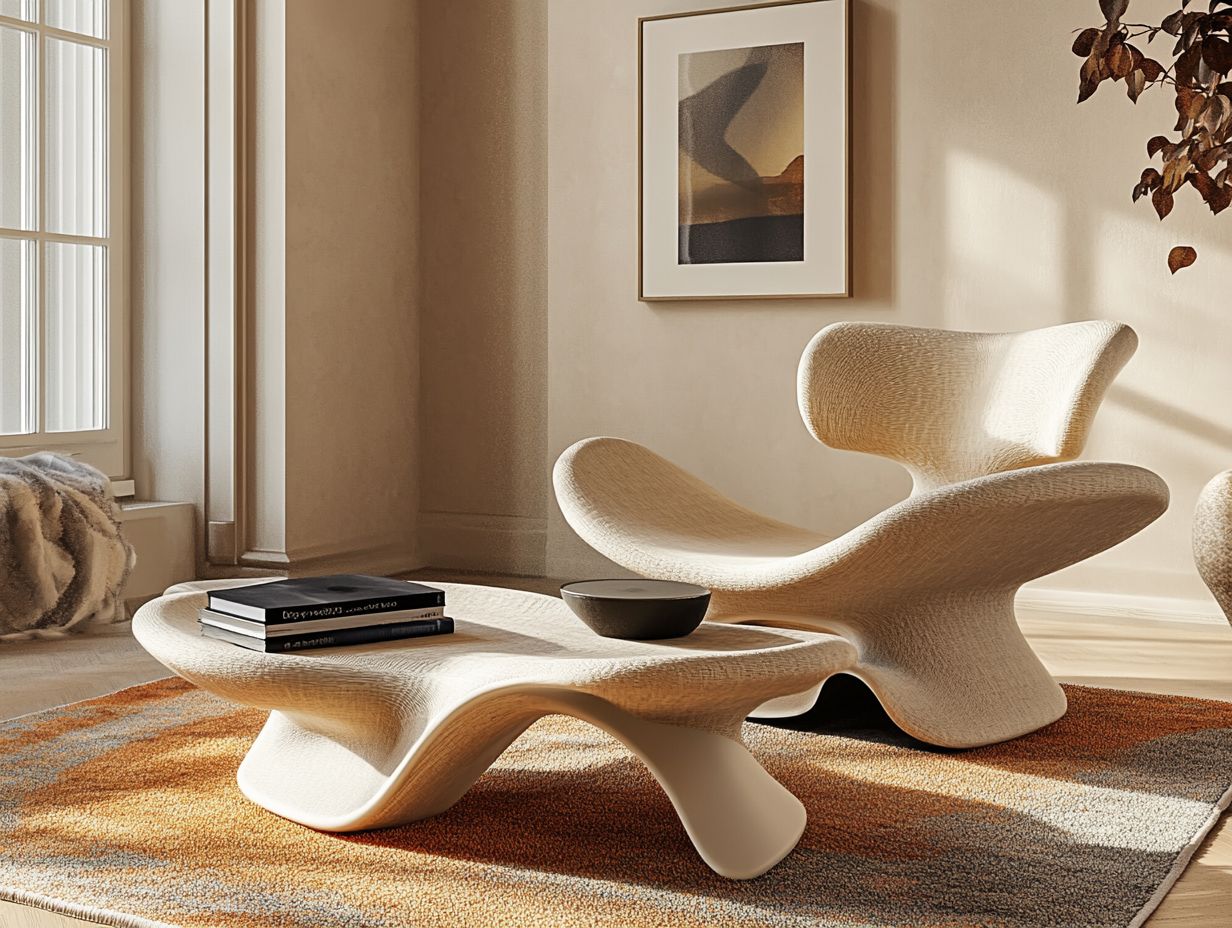
When selecting and designing 3D-printed furniture, consider factors like style and comfort. Your choices should enhance the overall quality of your home and reflect your personal aesthetic.
Think about how these pieces will complement other elements in your home, from color schemes to textures. A sleek, minimalist chair crafted through 3D printing could harmoniously blend with a modern, open-concept living area. A more ornate table might be just the right touch for a cozy dining room.
By focusing on design compatibility, you can create cohesive environments where each piece serves a functional purpose and becomes a focal point. This approach results in successful integrations that showcase the unique character of your space while meeting everyday practical needs.
What s Next for 3D-Printed Furniture?
The future of 3D-printed furniture holds great promise. Advancements in construction technology and sustainable housing solutions, as detailed in exploring the world of 3D-printed furniture design, are set to transform the furniture industry, making it more accessible for renters while tackling essential housing policies and environmental issues.
This evolution enhances your living space and aligns with a growing commitment to sustainability.
Potential for Sustainable and Affordable Housing Solutions
3D-printed furniture presents exceptional opportunities for sustainable and affordable housing solutions. With efficient production methods and the use of eco-friendly materials, it can significantly reduce the environmental impact typically tied to traditional furniture manufacturing.
By harnessing advanced technologies like additive manufacturing, you can minimize waste during production. Enjoy the freedom to create custom pieces tailored to your unique spatial needs. As urban living costs rise, incorporating 3D-printed furniture into housing projects becomes a cost-effective alternative that doesn t compromise quality or style.
The ease of recycling materials further enhances its appeal to environmentally conscious consumers eager to make a positive impact on their homes and the planet. Embracing this shift towards sustainable manufacturing could play a pivotal role in addressing the urgent housing crises we face today.
Impact on Traditional Furniture Industry
The rise of 3D-printed furniture is transforming the traditional furniture industry. It forces manufacturers to rethink how furniture is built and adapt to a rapidly evolving housing market driven by demand for innovative and affordable solutions.
As consumers increasingly seek personalized and eco-friendly options, this shift towards 3D printing is not just a trend. It represents a profound transformation that could redefine standards of sustainability and customization. This technological advancement allows for intricate designs that were once cost-prohibitive while enabling manufacturers to reduce waste, aligning perfectly with the values of environmentally conscious consumers.
In this dynamic landscape, traditional furniture makers must embrace these changes and rethink their strategies to stay competitive. This evolution will change how we design our homes and significantly enhance the overall living experience.
Frequently Asked Questions
What is 3D-printed furniture and why is it a game changer for renters?
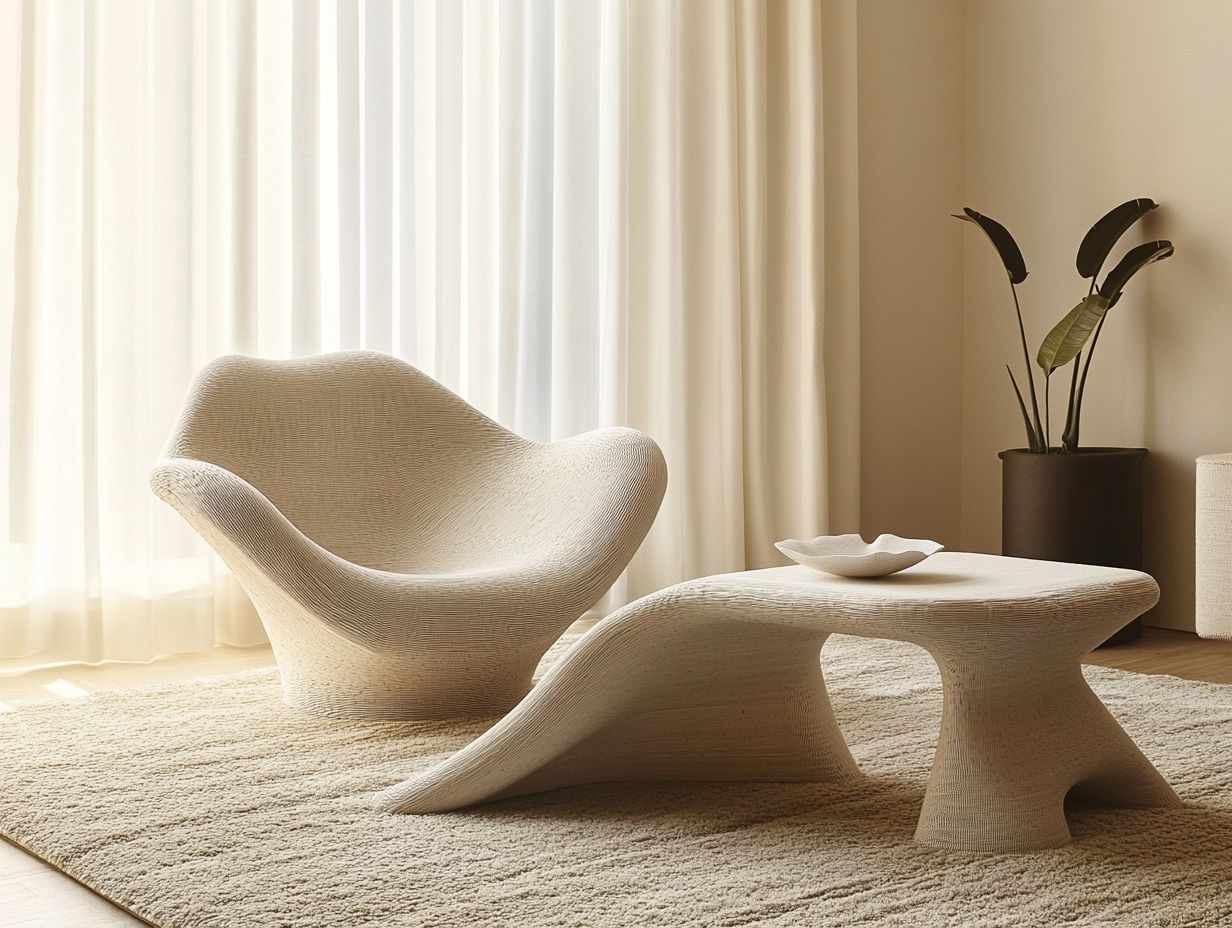
3D-printed furniture is created using a 3D printer, which allows for intricate, customizable designs. It is a game changer for renters because it offers a more affordable, sustainable, and convenient option for furnishing their homes, as highlighted in 3D-printed furniture innovations.
How is 3D-printed furniture more affordable for renters?
3D printing allows furniture to be made with less material and labor, resulting in lower production costs compared to traditional manufacturing methods. For those interested in unique designs, learning how to style your space with 3D-printed furniture can highlight this cost-saving, making it a more affordable option for furnishing their homes.
What makes 3D-printed furniture a sustainable choice for renters?
3D printing uses less energy and produces less waste compared to traditional manufacturing. With 3D-printed furniture, renters can reduce their carbon footprint while still enjoying stylish and functional furnishings.
Can renters customize their 3D-printed furniture?
Yes, one of the biggest advantages of 3D-printed furniture is the ability to customize designs. Renters can work with designers to create unique and personalized pieces that fit their specific needs and style preferences, as highlighted in how 3D printing is revolutionizing furniture design.
Is 3D-printed furniture durable enough for everyday use?
Yes, 3D-printed furniture is designed to be both functional and durable. The materials used are strong and can withstand everyday use, making it a practical choice for renters who want furniture that will last.
Where can renters find 3D-printed furniture?
3D-printed furniture is becoming more popular and can be found in various online stores and furniture shops. Some designers also offer customized 3D-printed furniture services, allowing renters to have unique and one-of-a-kind pieces for their homes.
Explore the exciting world of 3D-printed furniture today!


